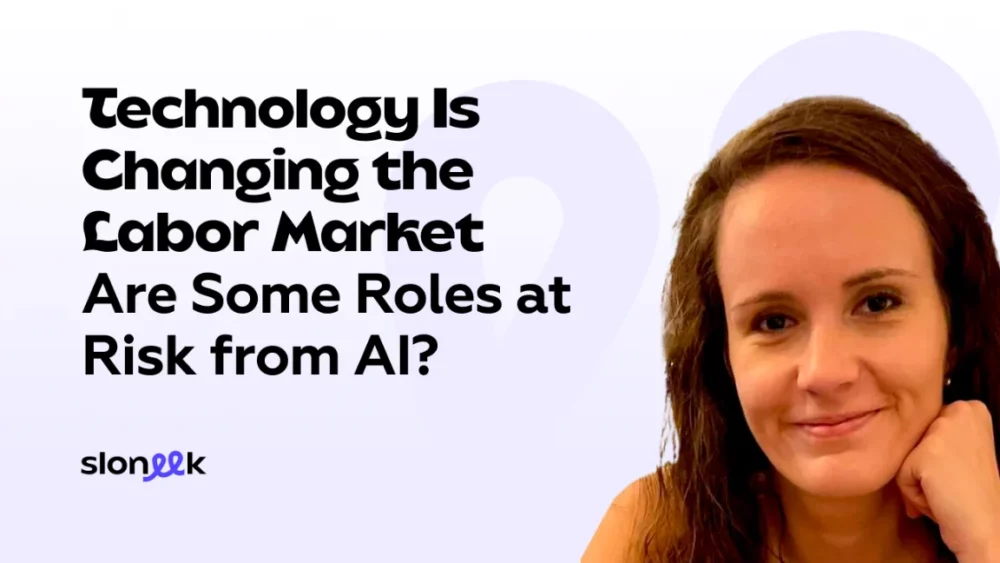Technology Is Changing the Labor Market – Are Some Roles at Risk from AI?

Artificial intelligence is a hotter topic than ever. Some see it as a tool that will make people’s work easier, while others view it as a threat that will take their jobs. The truth lies somewhere in the middle.
AI can indeed take over some routine and repetitive tasks, but at the same time, it creates new opportunities—often more skilled, interesting, and strategic than the ones it replaces. So, which roles might be at risk, which sectors are most affected by this technology, and how is the situation evolving in the Czech Republic and Slovakia?
Routine and Administrative Roles Are Most at Risk
According to analyses by the OECD and the World Economic Forum, professions based on repetitive tasks that can be easily automated are the most vulnerable. However, “at risk” does not mean these jobs will disappear overnight. Rather, their job descriptions are changing, and there is growing pressure for new skills.
These roles include:
- Administration, back-office, HR: Document processing, data entry, reporting, or working with spreadsheets. In HR, AI can automate routine tasks, and an ATS can, for example, sort resumes.
- Customer service and call centers: Chatbots and virtual assistants can already handle answers to frequently asked questions.
- Basic accounting and invoicing: Software can automatically recognize invoices, match payments, or prepare overviews.
- Junior IT roles: Some routine programming tasks can be automated by code-generating tools or development assistants, shifting some work to more experienced developers and architects.
Where Roles Are Changing, Not Disappearing
- HR: When AI takes over routine administration (e.g., resume screening, training scheduling), HR professionals gain time to focus on strategy, employee experience, talent development, and organizational culture—areas where humanity and empathy are key and cannot be replaced by a chatbot or other automation. This also opens up space for junior roles focused on people analytics, development coordination, and onboarding with an emphasis on communication.
- IT / Data: New entry-level opportunities are emerging around data labeling, model testing, prompt engineering, and AI tool management. Some of these roles require quick reskilling, but they also offer a real pathway for junior professionals.
- Marketing and Content: Instead of simple text and visual production, the emphasis is shifting to creative strategy and the ability to use AI effectively.
- Industry and Logistics: AI helps manage operations but also creates a demand for specialists who can work with these systems, evaluate data, and set up processes.
- Relationship-Based Professions: In customer relations, complex consulting, and sales, the emphasis is still on building a relationship with the client, which AI cannot yet replicate.

The Situation in the Czech Republic and Slovakia
According to OECD data, the Czech Republic is one of the European countries with the highest proportion of jobs at risk of partial automation. While business digitalization is growing, the adoption of generative AI varies by company size. OECD and local surveys show that companies are more likely to automate administrative processes first, with HR and marketing being early adopters. In Slovakia, it is estimated that generative AI will affect about a quarter of all workers, especially in regions with a higher share of routine professions. However, both countries have a relatively slow pace of AI adoption; most companies are in the testing phase of tools and administrative automation, not mass replacement of people.
Comparison with Other Countries
In the US and the UK, some analyses already show a decline in job postings for entry-level positions, especially in IT and administration. Companies prefer to hire more experienced workers who can use AI tools right away. In contrast, Nordic countries are investing more in reskilling and traineeships that prepare juniors to work with technology from the start, which is proving to be key to the long-term sustainability of the labor market.
What This Means for Companies and Individuals
For Companies:
- Automate routine tasks, but don’t underestimate the human element: Employees are the ones who bring innovation, creativity, and trust.
- Re-evaluate your recruitment strategy: Fewer mass postings for very basic, routine roles, and more investment in traineeships and projects that upskill new employees.
- Redirect HR capacity: Automate administration but invest in people development, culture, and leadership.
- Create reskilling plans: Identify tasks at high risk of automation and offer alternative career paths (e.g., Junior → Data Annotator → Junior AI Ops).
- Prepare for new roles: Such as AI coordinators, internal trainers, or ethical advisors for AI use.
- Ethics & AI Auditing: Even when cutting costs, careful oversight of AI deployment is necessary (risk of bias, legal liability).
For Employees:
- Learn to work with AI: Understand its limits and possibilities. This includes working with tools, basic data literacy, prompt engineering, and familiarity with automation tools.
- Get an overview of new AI-related job market positions and develop your existing skills in this direction.
- Develop your soft skills (e.g., communication, complex problem-solving) and strategic competencies.
- Be flexible: Career paths are changing, but new opportunities are also emerging. Some junior entry-level jobs will be in new areas (AI testing, data labeling, internal AI support).
Conclusion
AI is truly changing the labor market and partially reducing the number of some traditional junior roles—especially routine and administrative ones. However, this is not just the “end” of work; it is a transformation. In the Czech Republic and Slovakia, it is crucial for companies and educational institutions to invest in reskilling and traineeship programs. Job seekers, in turn, should invest in skills that AI cannot replace (communication, empathy, critical thinking, strategic work). This is perfectly illustrated in HR: when you implement an HR system and AI takes over administration, HR can become more strategic—which creates new, more valuable roles for people. There are still professions where AI is simply not enough, for example, in building relationships with customers, employees, or candidates.




